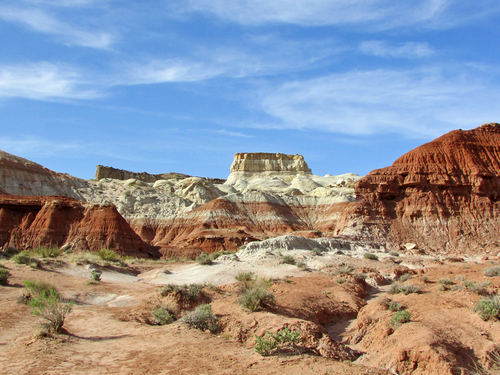6.2水平原则
章节大纲
-
What is the pattern of the Grand Canyon rock layers?
::大峡谷岩层的模式是什么?If you go to the Grand Canyon, you'll see layers of sedimentary . These rocks are extremely well exposed for viewing. Some people call this "layer cake geology ." It looks like a layer cake, but not as tasty. Just like a cake, the bottom layer is put down first. Subsequent layers are deposited next. Where the layers are not horizontal, there was deformation .
::如果你去大峡谷, 你会看到沉积层的层层。 这些岩石非常容易被查看。 一些人称它为“ 层蛋糕地质学 ” 。 它看起来像一个层蛋糕, 但没有那么好吃。 就像一个蛋糕一样, 底层先放下。 之后的层会沉积下来。 如果这些层不是水平的, 则会出现变形 。Sedimentary Rock Rules
::沉积岩规则Sedimentary rocks follow certain rules.
::沉积岩遵循某些规则- Sedimentary rocks form with the oldest layers on the bottom and the youngest on top.
::沉积岩形成最古老的层层在底部,最小的层在顶部。
- Sediments are deposited horizontally so sedimentary rock layers are originally horizontal.
::沉积物是水平沉积的,因此沉积岩层原来是水平的。
- Sedimentary rock layers that are not horizontal are deformed.
::非水平的沉积岩层变形。
Sedimentary rocks start out horizontal with the oldest on the bottom. Sedimentary rocks that are not horizontal must be deformed. This deformation produces geologic structures such as folds, joints, and that are caused by stresses. We can look at the deformation and structures out the deformation history of the rock.
::沉积岩从底部最古老的沉积岩石水平开始。非水平的沉积岩必须变形。这种变形会产生折叠、关节等地质结构,这些结构是由压力造成的。我们可以看看变形和结构,排除岩石的变形历史。Geologic Structures
::地质结构Sedimentary rocks are formed in horizontal layers. This is magnificently displayed around the southwestern United States. The arid climate allows rock layers to be well exposed ( Figure ). The lowest layers are the oldest, and the higher layers are younger. This concept is called superposition since it deals with the positions of rock layers.
::沉积岩由水平层形成。 这在美国西南部的周围展示得非常出色。 干旱的气候允许岩石层被很好地暴露( 图表 ) 。 最低层是最古老的,较高层更年轻。 这一概念被称为“ 叠加 ” , 因为它涉及岩石层的位置 。Layers of different types of rocks are exposed in this photo from Grand Staircase-Escalante National Monument. White layers of limestone are hard and form cliffs. Red layers of shale are flakier and form slopes.
::不同类型岩石的层层在大楼梯-Escalante国家纪念碑的这张照片中暴露,白色石灰岩层是硬的,形成悬崖,红页岩层是偏斜的,形成斜坡。Folds, joints, and faults are caused by stresses. If a sedimentary rock is tilted or folded, we know that stresses have changed the rock.
::折叠、关节和断层是由压力造成的。 如果沉积岩倾斜或折叠,我们知道压力改变了岩石。Summary
::摘要- Sedimentary rocks are laid down horizontally with the oldest at the bottom.
::沉积岩是横向铺设的 最古老的在底部
- Sedimentary rocks that are not horizontal have been deformed.
::非水平的沉积岩石已经变形。
- Sedimentary rocks are very useful for determining the deformation history of an area.
::沉积岩对于确定一个区域的变形历史非常有用。
Review
::回顾- Why are sediments laid down horizontally?
::为什么沉积物是横向铺设的?
- Why are sediments laid down from oldest to youngest?
::为什么沉积物是从最老到最年轻的?
- Why are sedimentary rocks so good for studying the geology of a region?
::为什么沉积岩对研究一个区域的地质学这么好?
Explore More
::探索更多Use the resource below to answer the questions that follow.
::利用以下资源回答以下问题。- How is rock laid down?
::岩石是如何铺设的?
- What is the law of superposition?
::什么是叠加法则?
- Why is the law of superposition important?
::为什么叠加法则很重要?
- Where is the oldest rock found?
::最古老的岩石在哪里被发现?
- Where is the youngest rock found?
::最年轻的岩石在哪里被发现?
- Why do we know that the fault is younger than the three rock layers?
::为什么我们知道错的比三个岩石层还小?
- Is the intrusion the youngest rock in the section? How do you know?
::那块地是最小的岩石吗?
- Sedimentary rocks form with the oldest layers on the bottom and the youngest on top.

